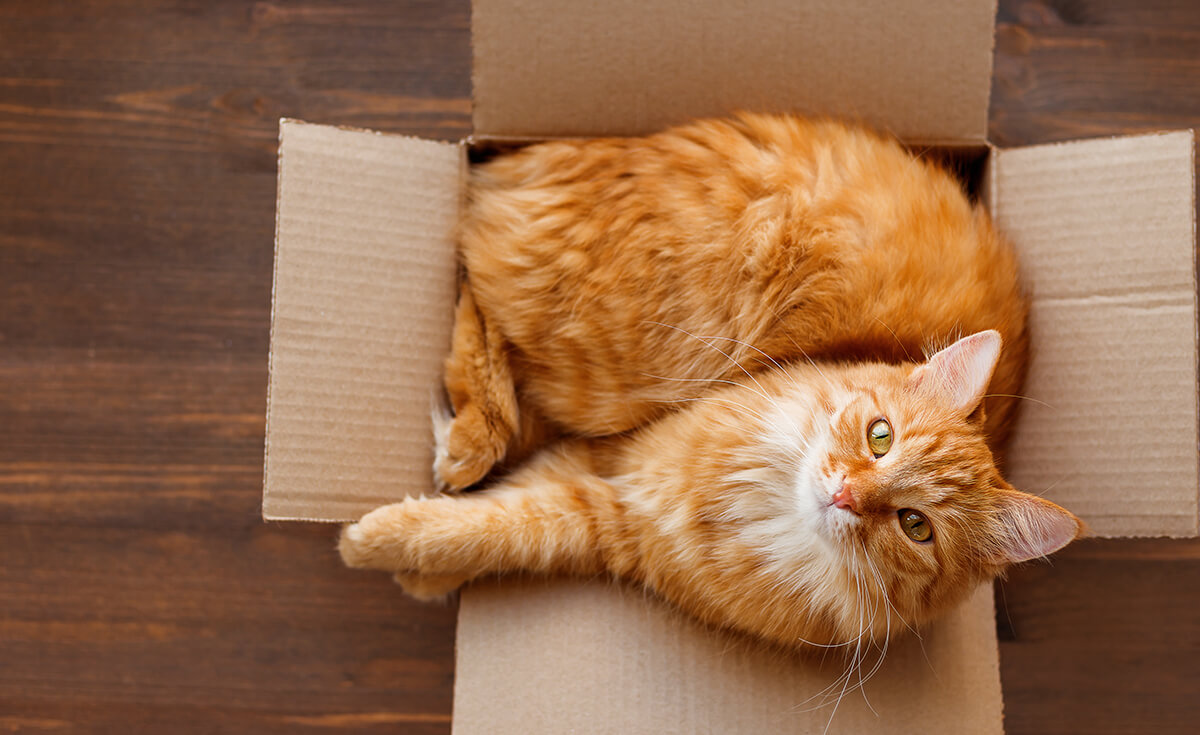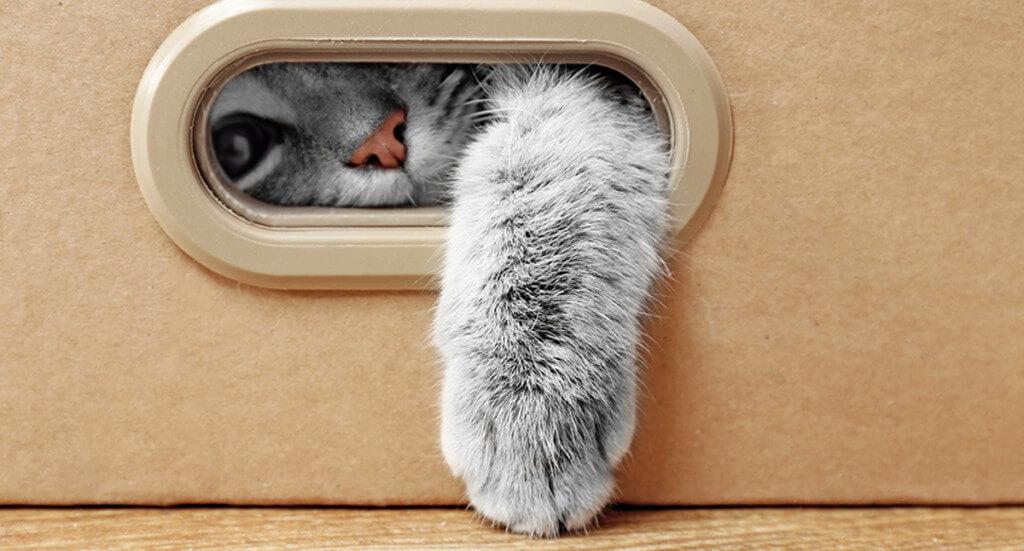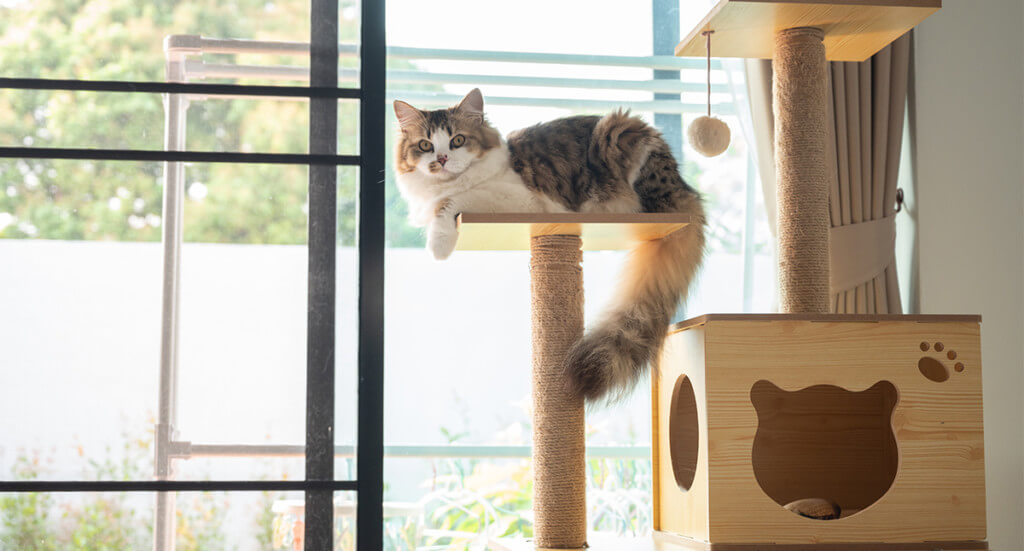Why Do Cats Like Boxes?
Ever wondered why your feline friend has an obsession with cardboard boxes? It’s a common yet puzzling behavior observed in most cats, captivating pet parents around the world. Whether it’s a small shoebox or a massive package, cats seem to find an inexplicable joy in these simple containers.
But what’s the hidden feline logic behind this love affair with boxes? In this article, we’ll dive into the main reasons that make boxes an irresistible attraction for cats. From their instinctual tendencies to the psychological benefits they derive, boxes offer more than just a plaything for our furry friends.

Reasons a Box is a Cat’s Best Friend
Boxes aren’t just cardboard to cats – they’re a mix of safety, play, and comfort. At a glance, this love might seem odd, but when we dive into a cat’s perspective, it all makes sense. Let’s explore why.
Instinctual Behavior
Cats are born with a natural instinct to stalk and pounce on anything that moves. This is an essential survival skill in the wild, even if it’s just a twitching tail or darting paw for domestic cats.
Our feline friends have a sharp sense of hearing and sight, which heightens during hunting sessions. Their love for boxes comes from this very primal instinct, as enclosed, confined spaces, like boxes mimic the vantage point they need before launching at their prey. Boxes provide perfect ambush spots where they can hide and play, fulfilling their inherent predatory behaviors without any real danger involved.
In addition, cats are territorial creatures that mark their domain to signal others of their presence. By sitting in a box or any confined space, it helps them create invisible boundaries that other animals know not to cross. Cats see boxes as their private spaces where they feel safe and in control. No one else is allowed in, making them feel more secure.
Sense of Security and Comfort
Cats find a remarkable sense of security and comfort in boxes. These enclosed spaces shelter cats and give them the feeling of being surrounded on all sides. Interestingly, this behavior mirrors that of big cats in the wild seeking out safe spaces.
That snug sensation allows your feline friend to relax entirely without worrying about potential threats sneaking up from behind. This sense of security is a huge reason why hiding boxes are often a favorite resting spot for cats.
Temperature Regulation and Insulation
Another reason why cats love boxes is because they’re excellent insulators. A cardboard box provides the perfect shield from cold floors and drafts, helping our feline friends maintain their body temperature.
In hot weather, empty boxes offer a cool retreat away from direct sunlight. That’s why cats often seek out boxes to curl up in. This behavior regulates body heat, acting as an adaptive strategy for them to thrive in different climate conditions.
Psychological Benefits for Cats
As mentioned earlier, boxes provide cats with safety and comfort. In this section, we’ll take a closer look at the psychological benefits of boxes for cats.

Stress Relief and Anxiety Reduction
Boxes play a crucial role in stress relief for cats. In a home with continuous activity or other pets, it can become quite overwhelming for them. This is where the box comes in, acting as a sanctuary, allowing them to unwind and feel safe amidst the chaos.
The small and confined space of a box gives cats a sense of privacy and seclusion, allowing them to hide away from stressful situations. This natural instinct helps cats cope with their surroundings and reduces their overall stress levels.
Ownership and Territory
Cats have a strong instinctual need for ownership and territory, which is why they often claim boxes as their own. By having a designated hiding spot like a box, cats can establish their personal space within a shared environment. This space acts as a clear boundary, signaling to other animals (and sometimes even to us) that this particular area is “off-limits.”
This territorial behavior traces back to their wild ancestors who needed to mark and defend their territories from potential rivals. In the domestic setting, though threats might be minimal, the instinct remains. Rubbing, scratching, and spending time in the box allows the cat to leave behind their scent, reinforcing their claim.
Privacy and Seclusion
Cats really value their alone time, and that’s a big reason they love boxes. These little cardboard hideaways offer them a quiet spot away from the usual household buzz. Inside a box, the world feels a bit calmer: sounds are softer, light is dimmer, and they’re hidden from any curious eyes.
But cats don’t just seek quiet moments because they’re shy – it’s in their nature. In the wild, finding a quiet spot helped them stay safe from danger. Even in our safe homes today, cats still like to find a spot to relax and have some alone time.
Boxes as Enrichment for Cats
Did you know that boxes can also be enrichment tools for your kitty? When cats pounce, peek, or swat toys inside a box, they’re not only having fun but also getting valuable mental stimulation. In this section, we’ll dive deeper into how these simple cardboard spaces can be turned into engaging enrichment activities for your feline friend.
Hunting and Play Opportunities
Cats love boxes because they provide hunting and play opportunities that satisfy their natural instincts. Here are some reasons why:
- Boxes offer a hiding spot for cats to stalk and pounce on imaginary prey.
- Cats can use boxes as a base for strategic ambushes during playtime.
- Boxes make great “hide-and-seek” spots, allowing cats to exercise their hunting skills.
- Cats enjoy scratching the sides of cardboard boxes, which simulates digging and marking territory.
- Boxes can be transformed into makeshift tunnels, creating a fun obstacle course for playful kitties.
Mental Stimulation and Environmental Enrichment
For cats, boxes aren’t just toys – they’re brain boosters. These curious creatures thrive on novelty and challenges, and every new box represents an opportunity to explore, problem-solve, and engage their senses.
Mental stimulation is vital for a cat’s cognitive health. Just as we benefit from puzzles or brain teasers, cats need their form of challenges to keep their minds active and sharp. The act of navigating a new box, figuring out its texture, or discovering a toy or treat hidden within, all serve to engage their intellect and curiosity.
Environmental enrichment, on the other hand, speaks to the broader concept of enhancing a cat’s surroundings. Cat owners know that a stimulated cat is often a content and well-behaved one.
By introducing varied elements like boxes into their environment, we mimic the complexities of the outdoors, ensuring they experience a rich and engaging indoor life. This variety not only prevents boredom but also reduces undesirable behaviors born out of frustration or lack of stimulation.
While boxes make excellent enrichment tools, they’re just one piece of the puzzle in creating a stimulating environment for our feline friends. Let’s take a look at some other enrichment ideas that can stimulate your furry friend’s senses.
Other Enrichment Ideas for Cats
To further enrich your cat’s environment, consider introducing a mix of interactive elements. Think about adding a cat tree or scratching post, offering interactive toys and puzzles, or creating vertical spaces and tunnels. Designated hiding spots also allow your feline friend ample opportunities to explore and engage in playful antics.
Cat Trees and Scratching Posts

Cat trees and scratching posts are essential items for every cat owner. They provide numerous benefits for your cat, such as:
- Climbing and exercise. Cat trees offer vertical spaces for cats to climb, providing them with much-needed exercise and keeping them active.
- Scratching outlet. Scratching posts give cats a designated spot to sharpen their claws, preventing them from damaging furniture or carpets.
- Territory marking. Cats use their scent glands in their paws to mark their territory by scratching on the surfaces. Having a scratching post helps them establish ownership in their environment.
- Mental stimulation. Cat trees often come with different levels and platforms, which can keep your cat mentally engaged. They can explore, jump, and hide on different parts of the tree, stimulating their curiosity.
- Environmental enrichment. Cat trees provide a variety of textures and surfaces that cats can explore, adding variety to their surroundings and giving them opportunities for play.
- Resting space. Many cat trees have cozy perches or enclosed cubbies where cats can curl up and relax. These elevated resting spots give cats a sense of security while still allowing them to observe their surroundings.
Interactive Toys and Puzzles
Interactive toys and puzzles are a great way to keep your pet cat entertained and mentally stimulated. Here are some options to consider:
- Treat-dispensing toys. These toys encourage your cat to work for their treats, keeping them mentally engaged and helping to prevent boredom. We recommend filling them with Earthborn Holistic dry cat food – a nutritious option that combines quality proteins with antioxidant-rich fruits and veggies, ensuring your kitty gets a tasty reward while playing!
- Puzzle toys. These interactive toys require your cat to figure out how to access a hidden treat or toy. They stimulate problem-solving skills and can provide hours of entertainment.
- Feather wands. Cats love chasing feathers, so using a feather wand toy is a great way to engage their hunting instincts and give them some exercise.
- Laser pointers. A laser pointer provides interactive play by allowing you to direct the light around the room. Just make sure not to shine it directly in your cat’s eyes.
- Catnip-filled toys. Many cats enjoy the effects of catnip, so providing toys filled with this herb can be a source of entertainment and play for them.
Vertical Spaces, Tunnels, and Hiding Spots
Cats love having vertical spaces, tunnels, and hiding spots in their environment. These provide opportunities for exploration and play, as well as a sense of security. Here are some ideas to incorporate these elements into your home:
- Cat trees. Invest in a sturdy cat tree with multiple levels and platforms for climbing and perching. This allows your cat to exercise and survey their territory from a higher vantage point.
- Tunnels. Create tunnels using materials like PVC pipes or purchase fabric tunnels designed for cats. Cats enjoy the feeling of hiding and exploring through narrow spaces, which can mimic hunting and stalking behaviors.
- Hiding spots. Provide cozy hiding spots throughout your home using various items such as cardboard boxes, blankets draped over furniture, or even specialized cat hideaways. These secluded areas give cats a safe space to retreat to when they need privacy or want to observe without being seen.
- Wall shelves and catwalks. Install wall-mounted shelves or create elevated walkways that allow your cat to move around the room at different heights. This not only provides exercise but also gives them an escape route if they feel threatened or overwhelmed.
- Cubbyholes and nooks. Designate certain corners or areas where you can create small enclosures using boxes or other cat-friendly materials like baskets or empty suitcases. Cats will appreciate having a cozy spot where they can curl up undisturbed.
Why Boxes (and More) Are Vital for Happy House Cats
The allure of boxes to cats stretches far beyond a simple love for cardboard. These humble containers tap into a cat’s primal instincts, offering security, entertainment, and a chance for mental stimulation. But, as essential as boxes are, they’re just one component of an enriched environment that cats need and deserve.
From cat trees to interactive toys, creating a stimulating environment for your feline friend ensures a healthier, happier life. After all, understanding and catering to the complex needs and behaviors of our furry companions make us not just cat owners but responsible caretakers of these wonderful creatures.




